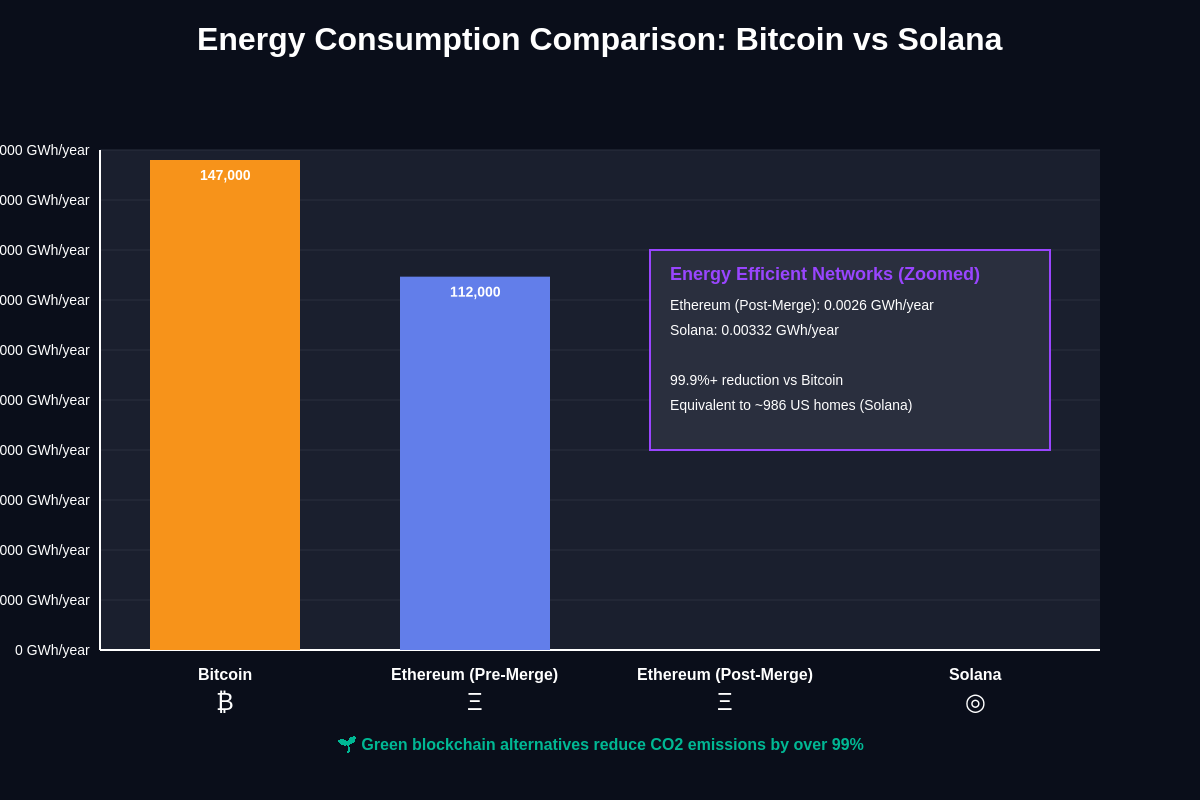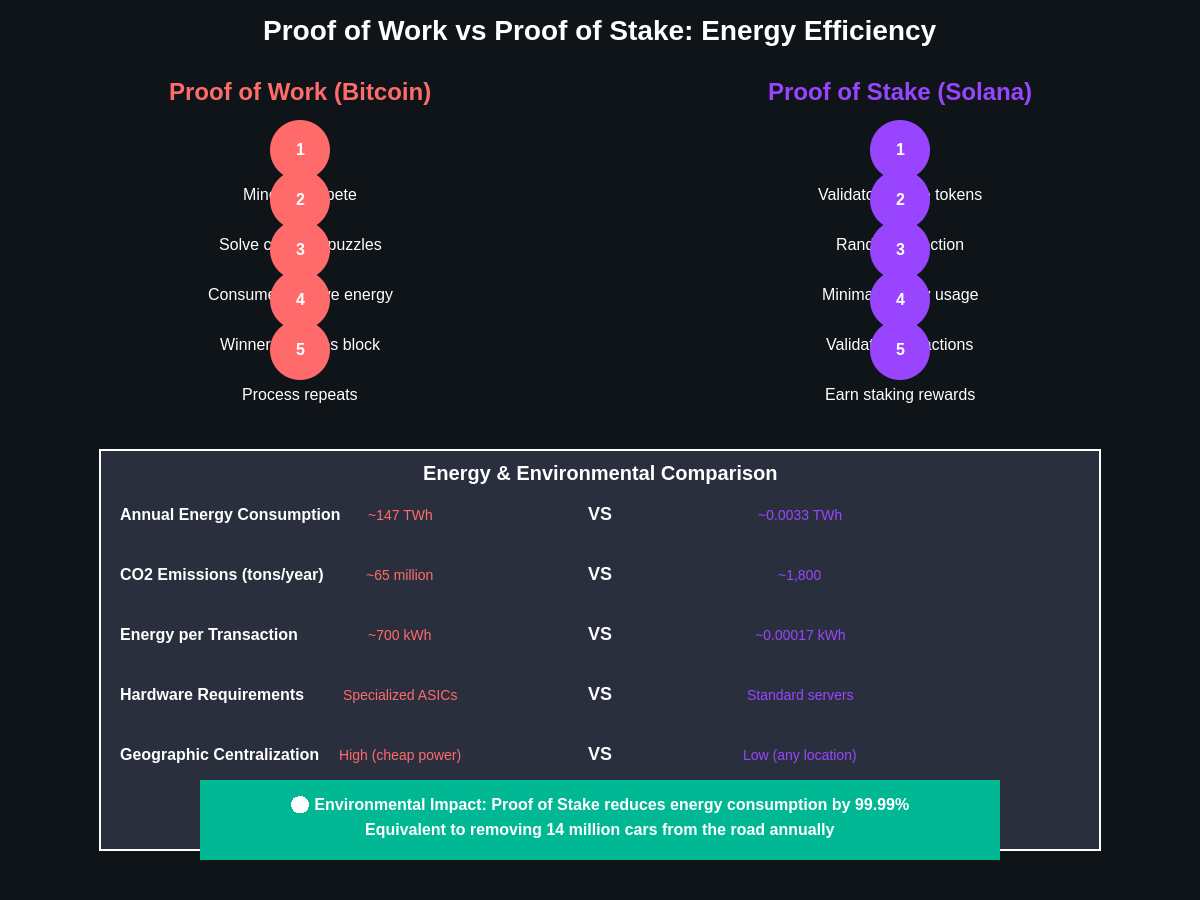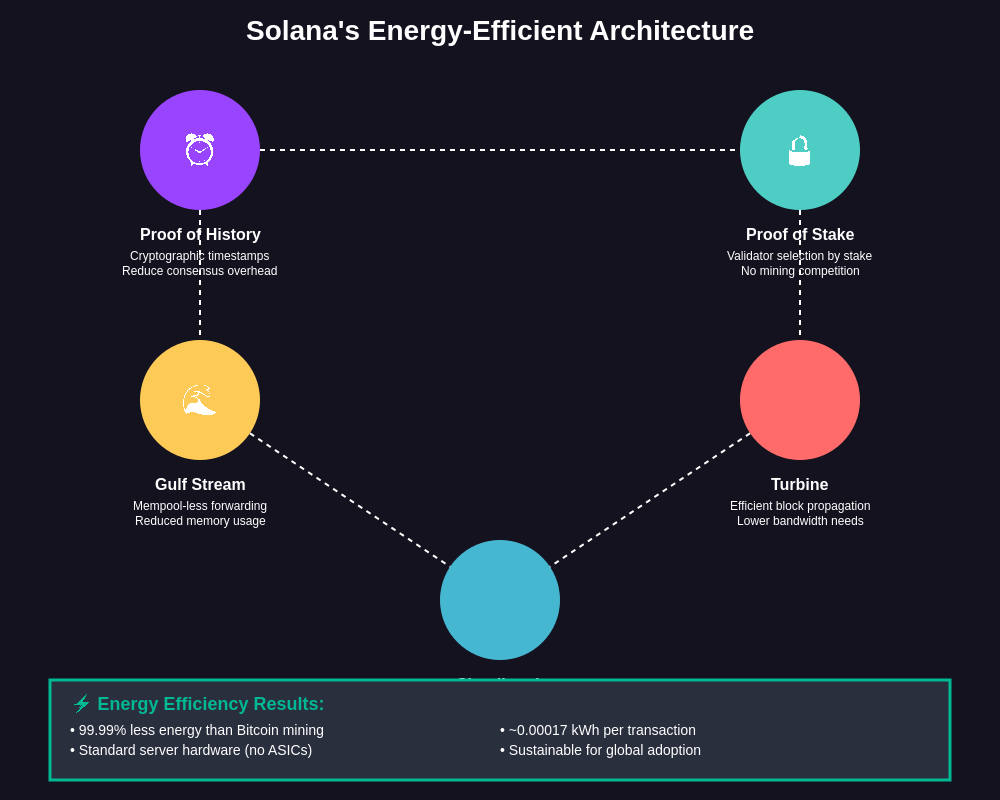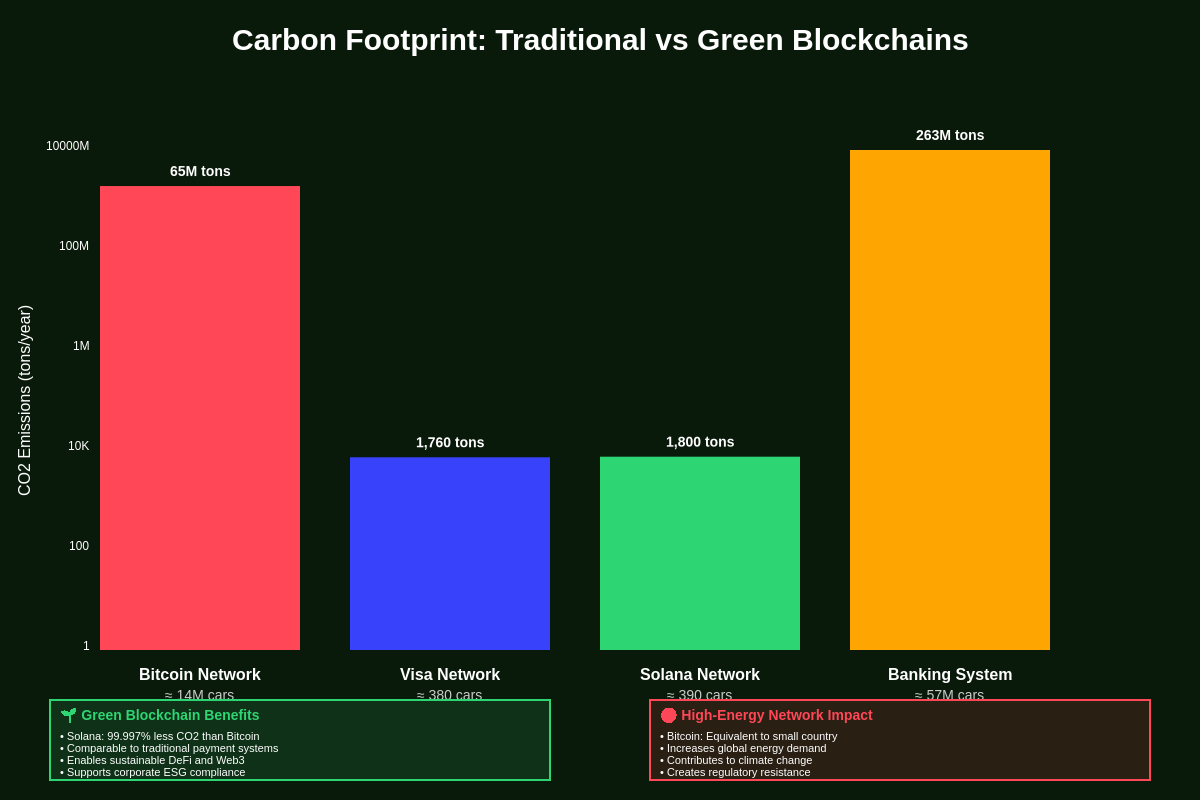The environmental impact of cryptocurrency has become one of the most contentious issues in the digital asset space, with Bitcoin’s energy-intensive proof-of-work mining drawing criticism from environmental advocates, regulators, and institutional investors. However, alternative blockchain networks like Solana have emerged as potential solutions to the sustainability challenge, offering dramatically reduced energy consumption while maintaining security and decentralization. Understanding the technical differences between these approaches and their real-world environmental implications is crucial for investors and users seeking to participate in sustainable cryptocurrency ecosystems while supporting the transition toward more environmentally responsible blockchain technologies.
The Bitcoin Mining Energy Crisis

Bitcoin’s proof-of-work consensus mechanism requires miners to compete in solving computationally intensive cryptographic puzzles, consuming vast amounts of electrical energy in the process. The Cambridge Bitcoin Electricity Consumption Index estimates that the Bitcoin network consumes approximately 120-150 terawatt-hours of electricity annually, comparable to the energy consumption of entire countries like Argentina or the Netherlands. This massive energy requirement stems from the inherent design of proof-of-work, where network security is directly proportional to the computational power dedicated to mining operations.
The environmental impact of Bitcoin mining extends beyond raw energy consumption to include carbon emissions, electronic waste from mining hardware, and resource depletion in regions where mining operations are concentrated. Mining farms often locate in areas with cheap electricity, which frequently means relying on fossil fuel-powered energy sources, though some operations have begun transitioning to renewable energy to reduce their environmental footprint and operational costs.
The criticism of Bitcoin’s energy consumption has intensified as the network has grown and institutional adoption has increased, with some investors and organizations refusing to support Bitcoin due to environmental concerns. Major corporations that had previously announced Bitcoin treasury holdings have faced pressure from stakeholders to reconsider their positions, while some countries have banned or restricted Bitcoin mining operations due to environmental and energy security concerns.
Solana’s Proof-of-Stake Revolution

Solana operates on a fundamentally different consensus mechanism that dramatically reduces energy consumption while maintaining network security and decentralization. The network uses a combination of proof-of-stake consensus and a novel proof-of-history mechanism that enables high-speed transaction processing with minimal environmental impact. Unlike Bitcoin’s competitive mining model, Solana validators are selected to process transactions based on their stake in the network, eliminating the need for energy-intensive computational competitions.
The proof-of-history mechanism adds a temporal element to transaction ordering, allowing the network to maintain consensus without requiring validators to communicate extensively about the timing and sequence of transactions. This innovation significantly reduces the computational overhead required for consensus while enabling the network to process thousands of transactions per second, making Solana both environmentally friendly and highly scalable compared to traditional proof-of-work networks.
Solana validators typically operate on standard server hardware rather than specialized mining equipment, further reducing the network’s environmental footprint through lower hardware requirements and reduced electronic waste. The network’s energy efficiency enables validators to operate profitably with much lower electricity costs, making the network accessible to a broader range of participants and reducing centralization risks associated with high-energy mining operations.
Energy Consumption Comparison Analysis
Independent analysis of Solana’s energy consumption reveals a stark contrast with Bitcoin’s environmental impact, with the Solana network consuming approximately 0.166 watt-hours per transaction compared to Bitcoin’s estimated 700+ watt-hours per transaction. This represents a reduction of over 99% in energy consumption per transaction, demonstrating the significant environmental benefits of proof-of-stake consensus mechanisms over traditional proof-of-work mining.
The total annual energy consumption of the Solana network is estimated at approximately 3.3 gigawatt-hours, roughly equivalent to the electricity consumption of 986 average American households. This figure includes the energy consumption of all validators, RPC nodes, and supporting infrastructure, providing a comprehensive view of the network’s environmental footprint. In comparison, Bitcoin’s annual energy consumption could power approximately 4.5 million American households, highlighting the dramatic difference in environmental impact between the two networks.
When considering the transaction throughput capabilities of each network, the energy efficiency disparity becomes even more pronounced. Solana’s ability to process thousands of transactions per second means that the network can handle significantly more economic activity per unit of energy consumed, making it a more sustainable choice for applications requiring high transaction volumes such as decentralized finance protocols, non-fungible token marketplaces, and payment systems.
Technical Architecture and Energy Optimization

Solana’s energy efficiency stems from several key technical innovations that optimize resource utilization without compromising security or decentralization. The proof-of-history mechanism creates a cryptographic timestamp for each transaction, allowing validators to agree on transaction ordering without extensive communication or computation. This approach eliminates much of the overhead associated with traditional consensus mechanisms while maintaining the security properties required for a decentralized network.
The network’s Gulf Stream mempool-less transaction forwarding system further reduces energy consumption by eliminating the need for validators to maintain large memory pools of pending transactions. Instead, transactions are forwarded directly to upcoming validators based on the proof-of-history sequence, reducing memory requirements and computational overhead while improving transaction processing efficiency.
Solana’s Turbine block propagation protocol optimizes data transmission between validators, breaking large blocks into smaller packets that can be transmitted more efficiently across the network. This approach reduces bandwidth requirements and processing overhead, contributing to the network’s overall energy efficiency while maintaining high throughput and low latency transaction processing capabilities.
The network’s Cloudbreak parallel smart contract runtime enables multiple transactions to be processed simultaneously when they don’t conflict with each other, maximizing hardware utilization efficiency and reducing the computational resources required per transaction. This parallel processing capability allows validators to make better use of modern multi-core processors, improving energy efficiency while enabling higher transaction throughput.
Environmental Benefits and Carbon Footprint

The environmental benefits of Solana extend beyond reduced energy consumption to include lower carbon emissions, reduced electronic waste, and minimal impact on local energy grids. The network’s low energy requirements mean that validators can more easily source electricity from renewable sources, with many validators already operating on solar, wind, or hydroelectric power to further reduce their environmental impact.
Solana’s reduced hardware requirements compared to Bitcoin mining result in significantly less electronic waste, as validators don’t need to continuously upgrade to more powerful mining equipment to remain competitive. The longer operational lifespan of validator hardware reduces the environmental impact associated with manufacturing, shipping, and disposing of specialized cryptocurrency mining equipment.
The distributed nature of Solana validation combined with low energy requirements means the network has minimal impact on local electricity grids, unlike large-scale Bitcoin mining operations that can strain regional power infrastructure. This characteristic makes Solana more compatible with existing energy systems and reduces the risk of contributing to electricity shortages or infrastructure stress in areas where validators operate.
Validator Economics and Network Sustainability
Solana’s energy-efficient design creates a more sustainable economic model for network participants, with validators able to operate profitably without the massive electricity costs associated with Bitcoin mining. The reduced operational costs lower the barrier to entry for new validators, promoting decentralization while maintaining network security through economic incentives rather than energy consumption.
The staking mechanism allows SOL token holders to participate in network security and earn rewards without directly operating validator infrastructure, creating a more inclusive economic model that doesn’t require technical expertise or significant hardware investments. This approach distributes network ownership more broadly while maintaining strong security guarantees through economic alignment between stakeholders and network health.
Validator rewards in the Solana ecosystem are primarily derived from transaction fees and inflationary token emissions rather than energy arbitrage, creating economic incentives that align with network usage and adoption rather than electricity costs. This model encourages validators to focus on providing reliable service and supporting network growth rather than optimizing for the cheapest available electricity sources.
Institutional Adoption and ESG Compliance
The environmental advantages of Solana have made it an attractive option for institutional investors and organizations with environmental, social, and governance mandates that preclude investment in high-energy cryptocurrency networks. Major corporations and financial institutions that avoided Bitcoin due to environmental concerns have shown increased interest in proof-of-stake networks like Solana that align with their sustainability commitments.
ESG-focused investment funds and sustainable finance initiatives have begun including Solana and other proof-of-stake cryptocurrencies in their portfolios while maintaining restrictions on proof-of-work assets like Bitcoin. This trend has created additional demand for environmentally friendly cryptocurrency networks and has contributed to the growth of the broader proof-of-stake ecosystem.
The regulatory environment has also become more favorable toward energy-efficient cryptocurrency networks, with some jurisdictions implementing preferential treatment for low-energy blockchain operations while restricting or banning high-energy mining activities. These regulatory developments have created additional incentives for the adoption of sustainable blockchain technologies and have positioned networks like Solana as compliant alternatives to traditional proof-of-work systems.
Real-World Applications and Green Use Cases
Solana’s energy efficiency has enabled the development of environmentally conscious applications that would be impractical on high-energy networks like Bitcoin. Carbon credit marketplaces built on Solana allow organizations to trade verified carbon offsets with minimal environmental impact from the underlying blockchain infrastructure, creating a sustainable foundation for climate action initiatives.
Renewable energy certificate trading platforms leverage Solana’s low-energy design to facilitate the buying and selling of green energy credits without contributing significantly to carbon emissions through network operations. These applications demonstrate how energy-efficient blockchain technology can support rather than undermine environmental sustainability efforts.
The network’s green credentials have attracted development of applications focused on environmental sustainability, including supply chain tracking for sustainable products, verification systems for renewable energy production, and platforms for coordinating environmental conservation efforts. These use cases highlight how blockchain technology can contribute positively to environmental goals when built on sustainable infrastructure.
Comparative Analysis with Other Networks
When compared to other major cryptocurrency networks, Solana consistently ranks among the most energy-efficient options while maintaining competitive performance characteristics. Ethereum’s transition to proof-of-stake with the merge has significantly reduced its energy consumption, though Solana’s innovative consensus mechanisms still provide superior energy efficiency per transaction processed.
Other proof-of-stake networks like Cardano and Polkadot also offer significant energy savings compared to Bitcoin, though Solana’s unique architectural innovations and high transaction throughput provide additional sustainability benefits through improved resource utilization efficiency. The competitive landscape of sustainable blockchain networks continues to evolve as developers implement new optimization techniques and consensus mechanisms.
Layer-two scaling solutions for Bitcoin and Ethereum can improve the energy efficiency of those networks by processing transactions off-chain, though they still rely on the underlying energy-intensive base layers for final settlement. Solana’s native high-throughput design eliminates the need for additional scaling layers while maintaining energy efficiency, providing a more direct path to sustainable blockchain operations.
Future Developments and Energy Optimization
Ongoing development efforts within the Solana ecosystem continue to focus on further improving energy efficiency and environmental sustainability while maintaining the network’s performance characteristics. Research into more efficient consensus mechanisms, improved validator hardware optimization, and better resource utilization techniques may yield additional energy savings in future network upgrades.
The growing focus on renewable energy adoption among Solana validators represents an additional avenue for reducing the network’s environmental impact, with initiatives underway to coordinate validator operations with clean energy availability and to incentivize renewable energy usage through validator selection mechanisms.
Integration with carbon offset markets and environmental monitoring systems may provide additional tools for measuring and mitigating the environmental impact of Solana network operations, creating transparency and accountability mechanisms that support continued improvement in sustainability metrics.
Economic Implications of Energy Efficiency
The energy efficiency advantages of Solana create significant economic benefits that extend beyond direct operational cost savings to include improved market access, reduced regulatory risk, and enhanced long-term sustainability of network operations. Organizations choosing Solana over high-energy alternatives can avoid potential carbon taxes, regulatory restrictions, and reputational risks associated with environmentally intensive cryptocurrency networks.
The lower barrier to entry for Solana validators compared to Bitcoin miners promotes geographic decentralization and reduces the concentration of network control in regions with cheap electricity. This decentralization improves network resilience while reducing the environmental impact of concentrated mining operations that can strain local energy infrastructure.
Market dynamics increasingly favor energy-efficient cryptocurrency networks as environmental concerns become more prominent in investment decisions and regulatory frameworks. The SOL token’s performance has benefited from this trend as investors seek exposure to sustainable blockchain technologies that align with long-term environmental and regulatory expectations.
Challenges and Limitations
Despite its significant energy efficiency advantages, Solana faces certain challenges and limitations that must be considered when evaluating its environmental impact and long-term sustainability. Network outages and performance issues have raised questions about the trade-offs between energy efficiency and network reliability, though ongoing development efforts continue to address these concerns through improved software and infrastructure.
The centralization risks associated with proof-of-stake consensus mechanisms require careful consideration, as large stakeholders can potentially exert disproportionate influence over network governance and operation. While Solana has implemented various mechanisms to promote decentralization, ongoing vigilance is required to ensure that energy efficiency gains don’t come at the expense of network decentralization and censorship resistance.
The relatively nascent state of the Solana ecosystem compared to more established networks like Bitcoin means that long-term sustainability and environmental impact assessments are based on shorter operational histories and may not fully account for potential future developments or challenges that could affect energy consumption patterns.
Disclaimer: This article is for informational purposes only and does not constitute financial or investment advice. Cryptocurrency investments carry significant risks including potential loss of principal. The environmental impact assessments and energy consumption figures cited in this article are based on available data and estimates that may change as networks evolve and measurement methodologies improve. Readers should conduct their own research and consider their risk tolerance before making investment decisions. Past performance does not guarantee future results, and the cryptocurrency market is highly volatile and subject to regulatory changes that may affect the viability and adoption of different blockchain networks.